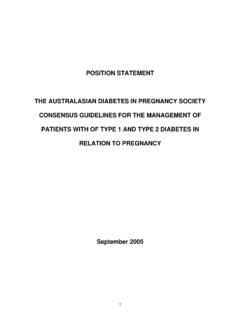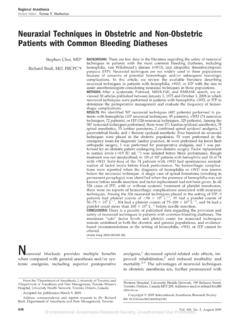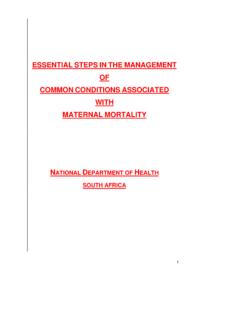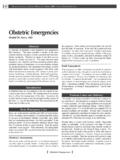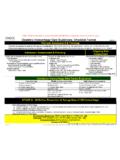Transcription of POSITION STATEMENT THE AUSTRALASIAN …
1 POSITION STATEMENT . THE AUSTRALASIAN DIABETES IN PREGNANCY SOCIETY. CONSENSUS GUIDELINES FOR THE management OF. PATIENTS WITH OF TYPE 1 AND TYPE 2 DIABETES IN. RELATION TO PREGNANCY. September 2005. 1. KEY RECOMMENDATIONS. Strict control of blood glucose levels should be pursued before conception and maintained throughout the pregnancy (HbA1c as close as possible to the normal range). High dose (5mg) folate supplementation should be commenced before conception. Oral hypoglycaemic agents should be ceased prior to conception. Diabetes complications screening should take place prior to conception. management should be by a multidisciplinary team experienced in the management of diabetes in pregnancy. Blood glucose monitoring is mandatory during pregnancy. Targets are: Fasting mmol/L; Post-prandial < mmol/L at 1 hour; <7mmol/L at 2 hours. A first trimester nuchal translucency (possibly with first trimester biochemical screening with PAPP-A and -hCG) should be offered.
2 Ultrasound should be performed for fetal morphology at 18 20 weeks, if required, for cardiac views at 24 weeks and for fetal growth at 28-30 and 34-36 weeks. Induction of labour or operative delivery should be based on obstetric and/or fetal indications. Level 3 neonatal nursing facilities may be required and should be anticipated when birth occurs before 36 weeks, or if there has been poor glycaemic control. Insulin requirements fall rapidly during labour and in the puerperium. Close monitoring and adjustment of insulin therapy is necessary at this time. INTRODUCTION. 2. The management of pregnancy in women who have Type 1 or Type 2 diabetes remains a challenging problem. The St Vincent declaration of 1989 set as a five-year target, the reduction of adverse pregnancy outcomes in women with Type 1 diabetes mellitus (T1DM), to a level equal to that of women without However, there is good evidence from many countries that this target has not been There is often a lack of awareness of the dangers posed by diabetes for pregnancy, particularly with Type 2 diabetes (T2DM) which is increasingly common and often undiagnosed prior to pregnancy.
3 Therefore in 2003, the AUSTRALASIAN Diabetes in Pregnancy Society (ADIPS) formed a working group comprising diabetes educators, endocrinologists, and obstetricians to formulate guidelines appropriate for the Australian setting. Where possible, literature searches were made through medline and further review of references in the papers examined. However, in may areas there was an absence of level 1 evidence and the combined experience and expertise of the writing group was drawn upon to arrive at the consensus guidelines. The core guidelines were published in the Medical Journal of Australia in 20058 (available at ). The following is a more comprehensive document which provides further information which could not be included in the published guidelines. The members of the ADIPS Pregestational Diabetes Guidelines Working Party were: Aidan McElduff, N Wah Cheung, H David McIntyre, Janet A Lagstrom, Jeremy JN Oats, Glynis P Ross, David Simmons, Barry NJ Walters, Peter Wein 3.
4 A. management OF WOMEN WITH DIABETES PRIOR TO. CONCEPTION. Information and counselling should be provided to all females of reproductive age with diabetes so that they are aware of the problems of diabetes in pregnancy, the potential dangers inherent in unplanned pregnancy and the benefits of prepregnancy counselling. The risks include increased perinatal mortality and malformation rates. These matters should be raised at each annual review of diabetic status or more frequently if required. A meta-analysis has demonstrated a significantly lower prevalence of major congenital anomalies in offspring women who attended for pre-pregnancy counselling (relative risk , 95% CI absolute risk vs )9. General General prepregnancy obstetric advice should be offered regarding the advantages of the following: a) cessation of smoking. b) reduced alcohol intake to within current NHMRC safety recommendations10.
5 C) review of all medications (including complementary) for safety in pregnancy. d) assessing immune status and screening for infectious diseases as recommended by the NHMRC. e) weight management and exercise prescription where appropriate. f) advice about contraception until conception is desired. Diabetes Specific Measures 4. management Personnel A multidisciplinary team experienced in the management of diabetes in pregnancy has been shown, in many countries11-14, to achieve superior obstetric and fetal outcomes relative to appropriate local comparators. This team should consist of people with an interest and experience in managing diabetes in pregnancy. Given the problems of health provider distribution and distances in Australia the personnel may have differing levels of expertise in different places. The team should consist of an obstetrician, endocrinologist (or physician experienced in diabetes care during pregnancy) diabetic educator and The importance of this preconception counselling and review cannot be underestimated.
6 Specific issues to be discussed by the management team include the clear benefits of optimal metabolic control prior to conception in reducing the risk of miscarriages, congenital malformations, perinatal mortality and other complications, and the benefits of taking folic acid 5mg daily for the prevention of neural tube defects15 (see Note 1). Vitamin B12 levels should be measured in women taking metformin. The optimal glycaemic targets should be made clear. At present the minimum standard set by the National Diabetes in Pregnancy Advisory Council is to achieve and maintain a target HbA1c of <1% above the normal range (generally <7%).16 However, there is evidence that the HbA1c should be maintained within the normal range if possible5,7 (see Note 2), whilst avoiding hypoglycaemia, and this is to be encouraged. This should be achievable in most patients with T2DM, but may not be possible in women with T1DM.
7 Women should not actively attempt pregnancy or embark on assisted reproductive treatment until the best available glycaemic control has been achieved. The review should include a reassessment of: diabetes education with the goal of ensuring adequate self- management skills including sick day care and hypoglycaemic management ;. 5. diet including suggestions for dealing with morning sickness; and, the physical activity regimen. Medications 1. Insulin Analogues There is increasing use of the newer rapid acting insulin analogues during pregnancy. There is more published information for lispro (Humalog ) than aspart (NovoRapid ) although a formal multicentre study will report shortly on the use of aspart in pregnancy. Recent cohort studies suggest that lispro is probably safe17-19 despite early case reports to the contrary20,21. Two reviews have concluded that the published data do not suggest that lispro or aspart are teratogenic, nor are they associated with adverse effects in ,23 Nevertheless, their use in pregnancy should be discussed with the woman.
8 There is little published experience with glargine (Lantus ), the new long acting insulin analogue, with only anecdotal cases of safety reported24,25. A recent review draws attention to the increased mitogenic potential of this agent and urges caution in pregnancy23. 2. Oral Hypoglycaemic Agents The gold standard for pharmacological hypoglycaemic therapy in pregnancy is insulin. Oral hypoglycaemic agents are not currently recommended because there is limited information regarding their safety in pregnancy. A meta-analysis26 suggests that the oral agents do not cause an increased risk of congenital malformations. Therefore they could be considered safe from this limited point of view. However, the authors themselves call for more data with oral agents in well controlled diabetes. ADIPS has recommended metformin therapy is not to be used routinely in women with pregnancies complicated by diabetes27 and its use requires further investigation in formal clinical trials prior to possible adoption for more widespread 6.
9 Use in pregnancy. When the potential harm from metformin therapy is likely to be outweighed by its benefits however, metformin therapy could be considered. Such situations include refusal of the patient to use insulin27. When pregnancy occurs on oral agents they should not be stopped precipitously; rather an urgent referral is indicated for careful transfer to insulin therapy avoid hyperglycaemia in the critical early period of gestation. 3. Anti-Hypertensive Medication Anti-hypertensive therapy in pregnancy has been reviewed by the AUSTRALASIAN Society for the Study of Hypertension in Pregnancy with guidelines formulated28 There is considerable evidence supporting the use of methyldopa, oxprenolol, clonidine, labetolol, prazosin and nifedipine in pregnancy (see Note 3). ACE inhibitors should be avoided in pregnancy as they are hazardous for the fetus in the third trimester, and of unproven safety in the ,30 If the woman has severe or difficult to control hypertension, it may be acceptable, after informed discussion, to continue the ACE inhibitor, ceasing it as soon as pregnancy occurs.
10 The effect of angiotensin 2 receptor blockers in pregnancy is unknown, but it is expected that it would be similar to ACE inhibitors. 4. Lipid Lowering Medication Fetal malformations have been documented in pregnancies where statins were continued in the first They are contra-indicated in pregnancy. Diabetes Complications Review Formal assessment for diabetes complications is essential, particularly retinopathy and nephropathy. The medical practitioner should advise women with diabetic complications of the risks they may encounter during pregnancy. Because of the risk of progression, some of these complications represent contraindications to pregnancy. 7. Retinopathy: The eye examination should be conducted through dilated pupils by a person experienced in retinal examination. Pre-existing retinopathy may progress more rapidly in Therefore, retinopathy which requires laser therapy should treated before pregnancy.
